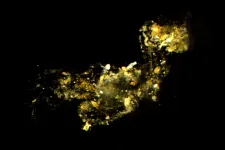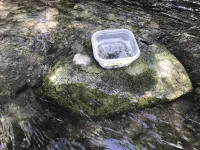(Press-News.org) A team of scientists from the Max Planck Institute for Marine Microbiology, the Max Planck Institute for Meteorology and the GEOMAR - Helmholtz Centre for Ocean Research Kiel have been studying biogeochemical processes in the oxygen minimum zone of the eastern South Pacific off Peru, one of the largest low oxygen regions of the world ocean. The researchers focused on so-called marine snow particles of different sizes, which are composed of algal debris and other organic material, aiming to understand how these particles affect the nitrogen cycle in the oxygen minimum zone. Thereby, they solved a long-standing puzzle: How do the nutrients that are concentrated inside the particles reach anammox bacteria that live freely suspended in the water column.
Too much of a good thing can be bad
Oxygen minimum zones are regions of the ocean where little to no oxygen is dissolved in the water. As most animals need oxygen to breathe, they cannot survive in these water bodies. Not surprisingly, oxygen minimum zones are also referred to as marine dead zones. Oxygen minimum zones are a natural phenomenon, but have been found to be expanding in many regions of the ocean as a result of human activity. Global warming contributes to decreasing oxygen concentrations, as warm water stores less oxygen. Warmer surface water also mix less with the deep, cool water below, thus leading to stagnation and reduced ventilation.
Changes to the nitrogen cycle also have deleterious effects on ocean oxygen concentrations. Nitrogen is a vital nutrient that animals and plants need in order to grow. Normally rare in the ocean, nitrogen compounds that can be processed have become increasingly available in many coastal regions. Humans use large amounts of fertilizers with nitrogen compounds such as ammonium and nitrate for agriculture and these nutrients find their way to the ocean via rivers and the atmosphere in ever increasing amounts.
This has severe consequences. The additional nutrients enhance phytoplankton growth. When the planktonic organisms die, they are decomposed by bacteria. During this process the bacteria consume oxygen, driving a decline in oxygen concentrations. Once oxygen is fully consumed, anaerobic microbial processes take over, during which microbes essentially "breathe" nitrogen compounds in place of oxygen, and as a result convert nitrate, nitrite and ammonium back to nitrogen gas and release it to the atmosphere.
Which factors drive the loss of nitrogen?
Combined, the anaerobic microbial respiration processes of anammox and denitrification in oxygen minimum zones lead to the loss of up to 40 percent of the oceans nitrogen. However the regulation of microbial Nitrogen-loss processes in oxygen minimum zones is still poorly understood. This study is focused on the anammox process, i.e. anaerobic ammonium oxidation with nitrite. In their project, the researchers followed up on the observation that the anammox process is particularly high when organic material in the form of marine snow particles is especially abundant. Their hypothesis was that the organic material, which contains a large amount of fixed nitrogen, serves as a source of ammonium for the anammox reaction. Strangely enough, anammox bacteria do not seem to live on the marine snow itself, but in the water column. So how do these bacteria find their nutrients?
To unravel this puzzle, the scientists used underwater cameras to measure particle abundances over depth profiles at different stations in the oxygen minimum zone off Peru. "We observed that the anammox process occurs mainly in places where the smaller particles are abundant," says Clarissa Karthäuser, shared first author of the paper with Soeren Ahmerkamp. "This indicates that the smaller particles are more important for the anammox process than the larger ones - whereby small means that they are about the size of a hair and thus barely visible".
These small particles are very abundant in the water column and sink slowly, thus they stay in the oxygen minimum zone longer. Also, the organic material is packed more densely in smaller particles and as a result the small flakes transport a similar amount of material per particle as the larger clumps, which means that overall they transport significantly more nitrogen. "We estimated that the ammonium concentration around the particles is significantly increased," says Soeren Ahmerkamp. "This indicates two things: First, that the higher number and longer residence times of the smaller particles in the water column increase the likelihood that bacteria will encounter a small particle by chance. Secondly, the high ammonium concentrations in the boundary layer of the particle can then provide nourishment to the bacteria."
Important results for earth system models
The new findings are crucial for the improvement of Earth system models. "With this study, we have resolved an important aspect of the anammox process and thus made an important contribution to a better understanding of the nutrient balance in the oceans," says Marcel Kuypers, head of the Department of Biogeochemistry of the Max Planck Institute for Marine Microbiology in Bremen. "With this improved process understanding, we provide the link between particle-associated processes and N-cycling in oxygen minimum zones which can be adapted in biogeochemical Earth system models to better assess the effects of anthropogenic deoxygenation on the nitrogen cycle."
INFORMATION:
Women carrying human papillomavirus (HPV) run an elevated risk of preterm birth, a University of Gothenburg study shows. A connection can thus be seen between the virus itself and the risk for preterm birth that previously has been observed in pregnant women who have undergone treatment for abnormal cell changes due to HPV.
A Swedish study now published in the high-ranking journal PLOS Medicine comprises data on more than a million births. Accordingly, the researchers have compared very large groups. They emphasize that the findings do not support any assessment of risk ...
In a study that will be published in Nature Communications on May 28, 2021, a research team led by Dr. Yuan Liu from Georgia State University reports that intratumoral SIRPα-deficient macrophages activate tumor antigen-specific cytotoxic T cells to eliminate various syngeneic cancers under radiotherapy.
As a major component of the suppressive tumor microenvironment, tumor-associated macrophages (TAMs) are generally regarded as facilitators of tumor progression. It has been shown that depleting TAMs can enhance the response of tumors to radiotherapy (RT). However, Yuan's ...
The average IQ of adults born very preterm or very low birth weight was compared to those who were term born in the 1970s to 1990s in 8 longitudinal cohorts from 7 countries around the world
The IQ was significantly lower for very pre-term and very low birth weight adults in comparison to those term born, researchers from the University of Warwick have found
Action needs to be taken to ensure support is available for those born very preterm or very low birth weight
The average IQ of adults who were born very preterm (VP) or at a very low birth weight (VLBW) has been compared to adults born full term by researchers from the Department of Psychology at the University of Warwick. Researchers have found VP/VLBW children may require special ...
A new extensive genetic resource of rat-infecting malaria parasites may help advance the development of malaria prevention and treatment strategies. This trove of genome and phenome information has been published1 by a team of KAUST researchers, along with colleagues in Japan, and the datasets have been made publicly available for malaria researchers.
Rodent malaria parasites are closely related to human parasites but are easier to study because they can be grown in laboratory mice. "Investigations on rodent malaria parasites have played a key role in revealing many aspects of fascinating biology across ...
It is time for the management and conservation of the Antarctic to begin focusing on responsibility, rather than rights, through an Indigenous Māori framework, a University of Otago academic argues.
In an article published in Nature Ecology & Evolution, Associate Professor Priscilla Wehi, of the Centre for Sustainability, says now is the time to be thinking of these potential changes.
"New Zealand is currently re-setting its priorities for future Antarctic research, and there may be review of the current international environmental conventions as we approach the 50-year anniversary of the protocols in 2048.
"We argue that Indigenous Māori frameworks offer powerful ways of thinking about how we protect the Antarctic, by focusing on ...
Invasive species, beware: Your days of hiding may be ending.
Biologists led by the University of Iowa discovered the presence of the invasive New Zealand mud snail by detecting their DNA in waters they were inhabiting incognito. The researchers employed a technique called environmental DNA (eDNA) to reveal the snails' existence, showing the method can be used to detect and control new, unknown incursions by the snail and other invasive species.
"eDNA has been used successfully with other aquatic organisms, but this is the first time it's been applied to detect a new invasive population of these snails, which are a destructive invasive species in fresh waters around the world," says Maurine Neiman, associate professor in the Department ...
How old is your brain compared to your chronological age? A new measure of brain health developed by researchers at Rush University Medical Center may offer a novel approach to identifying individuals at risk of memory and thinking problems, according to research results published in Alzheimer's & Dementia: The Journal of the Alzheimer's Association on June 1.
Dubbed the "cognitive clock" by the researchers, the tool is a measure of brain health based on cognitive performance. It may be used in the future to predict the likelihood of memory and thinking problems that develop ...
Rare disease experts detail the first results of an unprecedented collaboration to diagnose people living with unsolved cases of rare diseases across Europe. The findings are published today in a series of six papers in the European Journal of Human Genetics.
In the main publication, an international consortium, known as Solve-RD, explains how the periodic reanalysis of genomic and phenotypic information from people living with a rare disease can boost the chance of diagnosis when combined with data sharing across European borders on a massive scale. Using this new approach, a preliminary reanalysis of data from 8,393 individuals resulted in 255 new diagnoses, some with atypical manifestations of known diseases.
A complementary study ...
Scientists at Tokyo Institute of Technology (Tokyo Tech) have developed a wirelessly powered relay network for 5G systems. The proposed battery-free communication addresses the challenges of flexible deployment of relay networks. This design is both economical and energy-efficient. Such advances in 5G communications will create tremendous opportunities for a wide range of sectors.
The ever-increasing demand for wireless data bandwidth shows no sign of slowing down in the near future. Millimeter wave, a short wavelength spectrum, has shown great potential in 5G communications and beyond. To leverage ...
Sophia Antipolis - 1 June 2021: A study in 5.8 million children has found a higher incidence of stroke four decades later in those whose mother had high blood pressure or pre-eclampsia while pregnant. The research is presented at ESC Heart & Stroke 2021, an online scientific conference of the European Society of Cardiology (ESC).1
"Our findings indicate that hypertensive disorders during pregnancy are associated with increased risks of stroke and potentially heart disease in offspring up to the age of 41 years," said study author Dr. Fen Yang, PhD student, Karolinska Institutet, Stockholm, Sweden. "Studies with longer follow-up are needed to confirm the results and ...




